2017 FORD SUPER DUTY open gas tank
[x] Cancel search: open gas tankPage 179 of 636
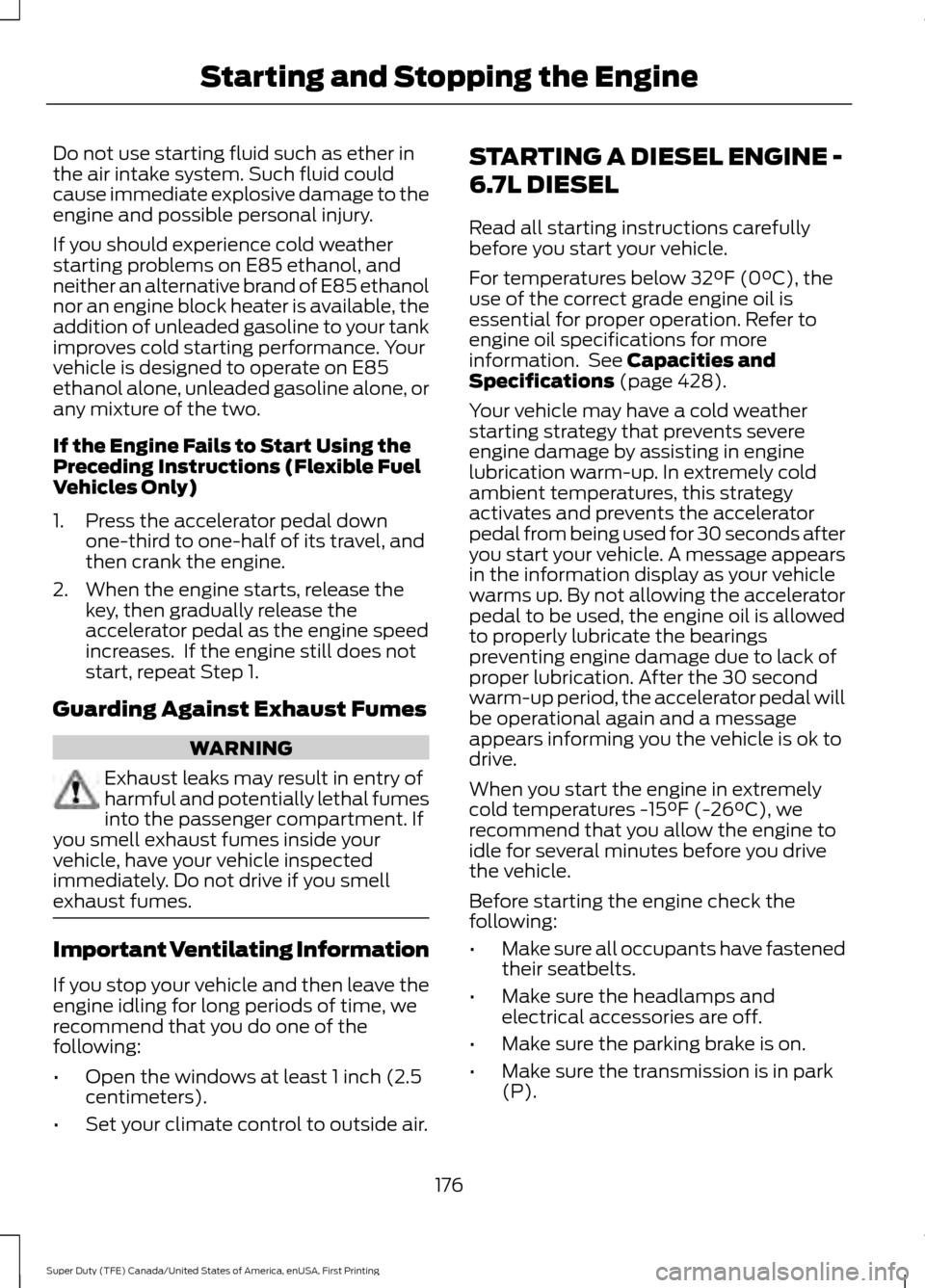
Do not use starting fluid such as ether in
the air intake system. Such fluid could
cause immediate explosive damage to the
engine and possible personal injury.
If you should experience cold weather
starting problems on E85 ethanol, and
neither an alternative brand of E85 ethanol
nor an engine block heater is available, the
addition of unleaded gasoline to your tank
improves cold starting performance. Your
vehicle is designed to operate on E85
ethanol alone, unleaded gasoline alone, or
any mixture of the two.
If the Engine Fails to Start Using the
Preceding Instructions (Flexible Fuel
Vehicles Only)
1. Press the accelerator pedal down
one-third to one-half of its travel, and
then crank the engine.
2. When the engine starts, release the key, then gradually release the
accelerator pedal as the engine speed
increases. If the engine still does not
start, repeat Step 1.
Guarding Against Exhaust Fumes WARNING
Exhaust leaks may result in entry of
harmful and potentially lethal fumes
into the passenger compartment. If
you smell exhaust fumes inside your
vehicle, have your vehicle inspected
immediately. Do not drive if you smell
exhaust fumes. Important Ventilating Information
If you stop your vehicle and then leave the
engine idling for long periods of time, we
recommend that you do one of the
following:
•
Open the windows at least 1 inch (2.5
centimeters).
• Set your climate control to outside air. STARTING A DIESEL ENGINE -
6.7L DIESEL
Read all starting instructions carefully
before you start your vehicle.
For temperatures below 32°F (0°C), the
use of the correct grade engine oil is
essential for proper operation. Refer to
engine oil specifications for more
information. See
Capacities and
Specifications (page 428).
Your vehicle may have a cold weather
starting strategy that prevents severe
engine damage by assisting in engine
lubrication warm-up. In extremely cold
ambient temperatures, this strategy
activates and prevents the accelerator
pedal from being used for 30 seconds after
you start your vehicle. A message appears
in the information display as your vehicle
warms up. By not allowing the accelerator
pedal to be used, the engine oil is allowed
to properly lubricate the bearings
preventing engine damage due to lack of
proper lubrication. After the 30 second
warm-up period, the accelerator pedal will
be operational again and a message
appears informing you the vehicle is ok to
drive.
When you start the engine in extremely
cold temperatures
-15°F (-26°C), we
recommend that you allow the engine to
idle for several minutes before you drive
the vehicle.
Before starting the engine check the
following:
• Make sure all occupants have fastened
their seatbelts.
• Make sure the headlamps and
electrical accessories are off.
• Make sure the parking brake is on.
• Make sure the transmission is in park
(P).
176
Super Duty (TFE) Canada/United States of America, enUSA, First Printing Starting and Stopping the Engine
Page 186 of 636

SAFETY PRECAUTIONS
WARNINGS
Do not overfill the fuel tank. The
pressure in an overfilled tank may
cause leakage and lead to fuel spray
and fire. The fuel system may be under
pressure. If you hear a hissing sound
near the fuel filler inlet, do not refuel
until the sound stops. Otherwise, fuel may
spray out, which could cause serious
personal injury. Automotive fuels can cause serious
injury or death if misused or
mishandled.
Flow of fuel through a fuel pump
nozzle can produce static electricity.
This can cause a fire if you are filling
an ungrounded fuel container. Fuel may contain benzene, which is
a cancer-causing agent.
When refueling always shut the
engine off and never allow sparks or
open flames near the fuel tank filler
valve. Never smoke or use a cell phone
while refueling. Fuel vapor is extremely
hazardous under certain conditions. Avoid
inhaling excess fumes. Observe the following guidelines when
handling automotive fuel:
•
Extinguish all smoking materials and
any open flames before refueling your
vehicle.
• Always turn off the vehicle before
refueling. •
Automotive fuels can be harmful or
fatal if swallowed. Fuel such as
gasoline is highly toxic and if
swallowed can cause death or
permanent injury. If fuel is swallowed,
call a physician immediately, even if no
symptoms are immediately apparent.
The toxic effects of fuel may not be
visible for hours.
• Avoid inhaling fuel vapors. Inhaling too
much fuel vapor of any kind can lead
to eye and respiratory tract irritation.
In severe cases, excessive or prolonged
breathing of fuel vapor can cause
serious illness and permanent injury.
• Avoid getting fuel liquid in your eyes. If
fuel is splashed in the eyes, remove
contact lenses (if worn), flush with
water for 15 minutes and seek medical
attention. Failure to seek proper
medical attention could lead to
permanent injury.
• Fuels can also be harmful if absorbed
through the skin. If fuel is splashed on
the skin, clothing or both, promptly
remove contaminated clothing and
wash skin thoroughly with soap and
water. Repeated or prolonged skin
contact with fuel liquid or vapor causes
skin irritation.
• Be particularly careful if you are taking
Antabuse or other forms of Disulfiram
for the treatment of alcoholism.
Breathing gasoline vapors could cause
an adverse reaction, serious personal
injury or sickness. If fuel is splashed on
the skin, wash the affected areas
immediately with plenty of soap and
water. Consult a physician immediately
if you experience any adverse reactions.
183
Super Duty (TFE) Canada/United States of America, enUSA, First Printing Fuel and Refueling
Page 187 of 636
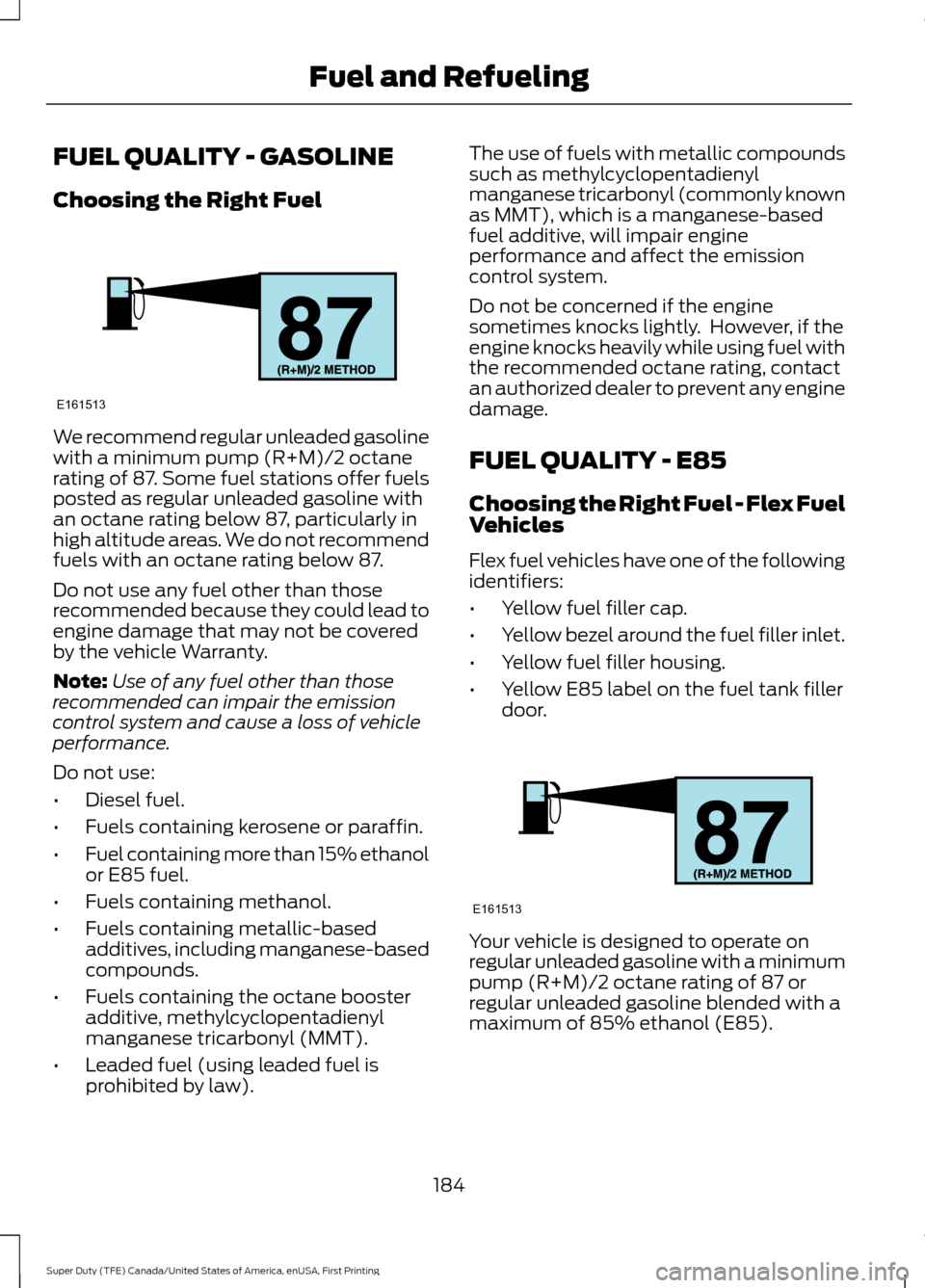
FUEL QUALITY - GASOLINE
Choosing the Right Fuel
We recommend regular unleaded gasoline
with a minimum pump (R+M)/2 octane
rating of 87. Some fuel stations offer fuels
posted as regular unleaded gasoline with
an octane rating below 87, particularly in
high altitude areas. We do not recommend
fuels with an octane rating below 87.
Do not use any fuel other than those
recommended because they could lead to
engine damage that may not be covered
by the vehicle Warranty.
Note:
Use of any fuel other than those
recommended can impair the emission
control system and cause a loss of vehicle
performance.
Do not use:
• Diesel fuel.
• Fuels containing kerosene or paraffin.
• Fuel containing more than 15% ethanol
or E85 fuel.
• Fuels containing methanol.
• Fuels containing metallic-based
additives, including manganese-based
compounds.
• Fuels containing the octane booster
additive, methylcyclopentadienyl
manganese tricarbonyl (MMT).
• Leaded fuel (using leaded fuel is
prohibited by law). The use of fuels with metallic compounds
such as methylcyclopentadienyl
manganese tricarbonyl (commonly known
as MMT), which is a manganese-based
fuel additive, will impair engine
performance and affect the emission
control system.
Do not be concerned if the engine
sometimes knocks lightly. However, if the
engine knocks heavily while using fuel with
the recommended octane rating, contact
an authorized dealer to prevent any engine
damage.
FUEL QUALITY - E85
Choosing the Right Fuel - Flex Fuel
Vehicles
Flex fuel vehicles have one of the following
identifiers:
•
Yellow fuel filler cap.
• Yellow bezel around the fuel filler inlet.
• Yellow fuel filler housing.
• Yellow E85 label on the fuel tank filler
door. Your vehicle is designed to operate on
regular unleaded gasoline with a minimum
pump (R+M)/2 octane rating of 87 or
regular unleaded gasoline blended with a
maximum of 85% ethanol (E85).
184
Super Duty (TFE) Canada/United States of America, enUSA, First Printing Fuel and RefuelingE161513 E161513
Page 188 of 636
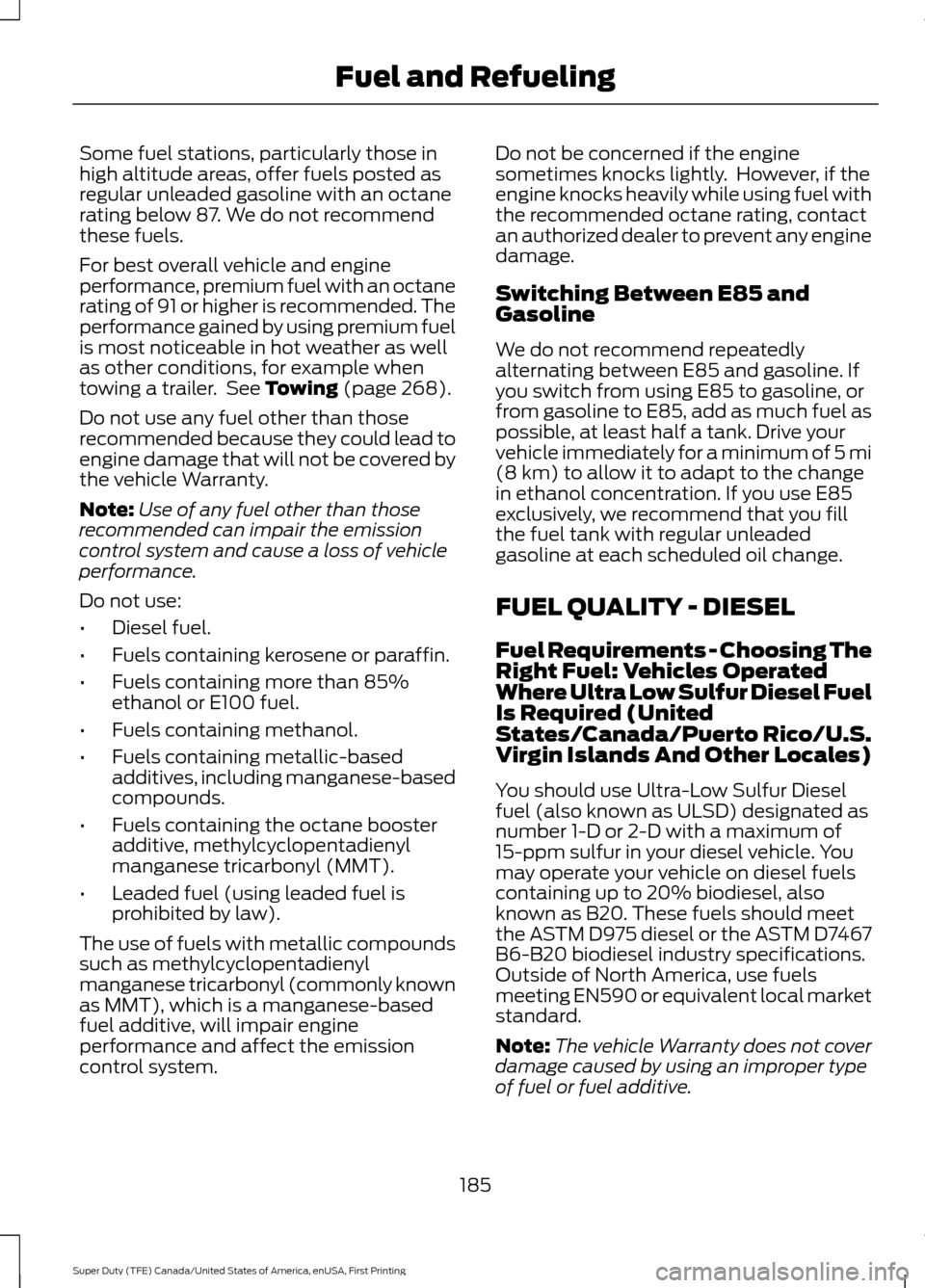
Some fuel stations, particularly those in
high altitude areas, offer fuels posted as
regular unleaded gasoline with an octane
rating below 87. We do not recommend
these fuels.
For best overall vehicle and engine
performance, premium fuel with an octane
rating of 91 or higher is recommended. The
performance gained by using premium fuel
is most noticeable in hot weather as well
as other conditions, for example when
towing a trailer. See Towing (page 268).
Do not use any fuel other than those
recommended because they could lead to
engine damage that will not be covered by
the vehicle Warranty.
Note: Use of any fuel other than those
recommended can impair the emission
control system and cause a loss of vehicle
performance.
Do not use:
• Diesel fuel.
• Fuels containing kerosene or paraffin.
• Fuels containing more than 85%
ethanol or E100 fuel.
• Fuels containing methanol.
• Fuels containing metallic-based
additives, including manganese-based
compounds.
• Fuels containing the octane booster
additive, methylcyclopentadienyl
manganese tricarbonyl (MMT).
• Leaded fuel (using leaded fuel is
prohibited by law).
The use of fuels with metallic compounds
such as methylcyclopentadienyl
manganese tricarbonyl (commonly known
as MMT), which is a manganese-based
fuel additive, will impair engine
performance and affect the emission
control system. Do not be concerned if the engine
sometimes knocks lightly. However, if the
engine knocks heavily while using fuel with
the recommended octane rating, contact
an authorized dealer to prevent any engine
damage.
Switching Between E85 and
Gasoline
We do not recommend repeatedly
alternating between E85 and gasoline. If
you switch from using E85 to gasoline, or
from gasoline to E85, add as much fuel as
possible, at least half a tank. Drive your
vehicle immediately for a minimum of 5 mi
(8 km)
to allow it to adapt to the change
in ethanol concentration. If you use E85
exclusively, we recommend that you fill
the fuel tank with regular unleaded
gasoline at each scheduled oil change.
FUEL QUALITY - DIESEL
Fuel Requirements - Choosing The
Right Fuel: Vehicles Operated
Where Ultra Low Sulfur Diesel Fuel
Is Required (United
States/Canada/Puerto Rico/U.S.
Virgin Islands And Other Locales)
You should use Ultra-Low Sulfur Diesel
fuel (also known as ULSD) designated as
number 1-D or 2-D with a maximum of
15-ppm sulfur in your diesel vehicle. You
may operate your vehicle on diesel fuels
containing up to 20% biodiesel, also
known as B20. These fuels should meet
the ASTM D975 diesel or the ASTM D7467
B6-B20 biodiesel industry specifications.
Outside of North America, use fuels
meeting EN590 or equivalent local market
standard.
Note: The vehicle Warranty does not cover
damage caused by using an improper type
of fuel or fuel additive.
185
Super Duty (TFE) Canada/United States of America, enUSA, First Printing Fuel and Refueling
Page 204 of 636
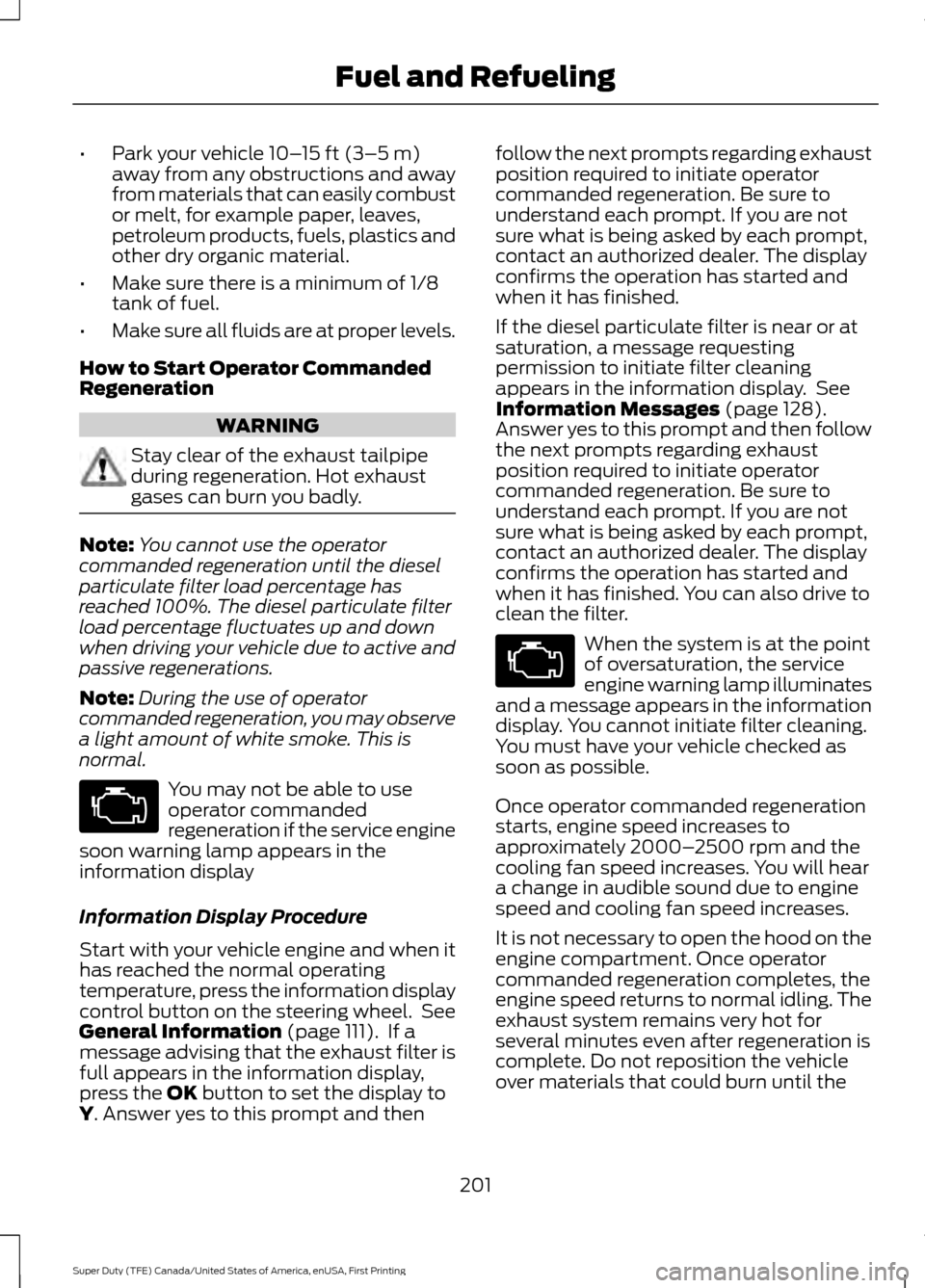
•
Park your vehicle 10– 15 ft (3–5 m)
away from any obstructions and away
from materials that can easily combust
or melt, for example paper, leaves,
petroleum products, fuels, plastics and
other dry organic material.
• Make sure there is a minimum of 1/8
tank of fuel.
• Make sure all fluids are at proper levels.
How to Start Operator Commanded
Regeneration WARNING
Stay clear of the exhaust tailpipe
during regeneration. Hot exhaust
gases can burn you badly.
Note:
You cannot use the operator
commanded regeneration until the diesel
particulate filter load percentage has
reached 100%. The diesel particulate filter
load percentage fluctuates up and down
when driving your vehicle due to active and
passive regenerations.
Note: During the use of operator
commanded regeneration, you may observe
a light amount of white smoke. This is
normal. You may not be able to use
operator commanded
regeneration if the service engine
soon warning lamp appears in the
information display
Information Display Procedure
Start with your vehicle engine and when it
has reached the normal operating
temperature, press the information display
control button on the steering wheel. See
General Information
(page 111). If a
message advising that the exhaust filter is
full appears in the information display,
press the
OK button to set the display to
Y. Answer yes to this prompt and then follow the next prompts regarding exhaust
position required to initiate operator
commanded regeneration. Be sure to
understand each prompt. If you are not
sure what is being asked by each prompt,
contact an authorized dealer. The display
confirms the operation has started and
when it has finished.
If the diesel particulate filter is near or at
saturation, a message requesting
permission to initiate filter cleaning
appears in the information display. See
Information Messages
(page 128).
Answer yes to this prompt and then follow
the next prompts regarding exhaust
position required to initiate operator
commanded regeneration. Be sure to
understand each prompt. If you are not
sure what is being asked by each prompt,
contact an authorized dealer. The display
confirms the operation has started and
when it has finished. You can also drive to
clean the filter. When the system is at the point
of oversaturation, the service
engine warning lamp illuminates
and a message appears in the information
display. You cannot initiate filter cleaning.
You must have your vehicle checked as
soon as possible.
Once operator commanded regeneration
starts, engine speed increases to
approximately 2000– 2500 rpm and the
cooling fan speed increases. You will hear
a change in audible sound due to engine
speed and cooling fan speed increases.
It is not necessary to open the hood on the
engine compartment. Once operator
commanded regeneration completes, the
engine speed returns to normal idling. The
exhaust system remains very hot for
several minutes even after regeneration is
complete. Do not reposition the vehicle
over materials that could burn until the
201
Super Duty (TFE) Canada/United States of America, enUSA, First Printing Fuel and Refueling
Page 628 of 636

Heated Exterior Mirrors .....................................
98
Memory Mirrors ................................................... 98
Power Exterior Mirrors........................................ 96
PowerScope ™ Power Telescoping
Mirrors.................................................................. 97
Puddle Lamps....................................................... 98
Spot Lamps........................................................... 98
Telescoping Mirrors.............................................. 97
Trailer Towing Camera System....................... 98
F
Fastening the Seatbelts..............................36 Fastening the Cinch Tongue............................. 37
Rear Inflatable Seatbelt.................................... 39
Seatbelt Locking Modes.................................... 38
Using Seatbelts During Pregnancy................37
Using the Seatbelt with Cinch Tongue (Front Center Seat on Super Cab and
Crew Cab).......................................................... 36
Floor Mats........................................................291
Fog Lamps - Front See: Front Fog Lamps........................................ 90
Foot Pedals See: Adjusting the Pedals................................. 83
Ford Credit
.........................................................12
US Only...................................................................... 12
Ford Protect
...................................................565
Ford Protect (CANADA ONLY)....................566
Ford Protect Extended Service Plans (U.S.
Only).................................................................. 565
Four-Wheel Drive
.........................................210
Front Fog Lamps............................................90
Front Seat Armrest......................................162 ........................................................................\
........... 162
Fuel and Refueling
.......................................183
Fuel Consumption.......................................195 Calculating Fuel Economy.............................. 196
Filling the Fuel Tank.......................................... 196
Fuel Filter - 6.2L/6.8L.................................343
Fuel Quality - Diesel....................................185 Biodiesel................................................................ 186
Diesel Fuel Additives......................................... 188
Fuel Requirements - Choosing The Right Fuel: Vehicles Operated Where Ultra Low
Sulfur Diesel Fuel Is Not Required .........186 Fuel Requirements - Choosing The Right
Fuel: Vehicles Operated Where Ultra Low
Sulfur Diesel Fuel Is Required (United
States/Canada/Puerto Rico/U.S. Virgin
Islands And Other Locales) ...................... 185
Fuel Quality - E85........................................184 Choosing the Right Fuel - Flex Fuel
Vehicles............................................................. 184
Switching Between E85 and Gasoline............................................................ 185
Fuel Quality - Gasoline...............................184 Choosing the Right Fuel.................................. 184
Fuel Shutoff - 6.2L/6.8L...........................296
Fuel Shutoff - 6.7L Diesel
..........................297
Running Out Of DEF (Diesel Exhaust
Fluid).................................................................. 297
Fuses.................................................................310
Fuse Specification Chart...........................310 Passenger Compartment Fuse Panel.........315
Power Distribution Box..................................... 310
G
Garage Door Opener See: Universal Garage Door Opener...........164
Gauges ..............................................................
102
DEF Gauge............................................................ 105
Engine Coolant Temperature Gauge..........104
Engine Oil Pressure Gauge............................. 104
Fuel Gauge............................................................ 104
Transmission Fluid Temperature Gauge................................................................. 105
Turbo Boost Gauge............................................ 105
Type 1 and 2.......................................................... 102
Type 3..................................................................... 103
General Information on Radio Frequencies...................................................54
Intelligent Access................................................. 54
General Maintenance Information........567 Multi-point Inspection..................................... 569
Owner Checks and Services......................... 568
Protecting Your Investment........................... 567
Why Maintain Your Vehicle?.......................... 567
Why Maintain Your Vehicle at Your Dealership?..................................................... 567
Getting Assistance Outside the U.S. and Canada.........................................................306
625
Super Duty (TFE) Canada/United States of America, enUSA, First Printing Index
Page 631 of 636
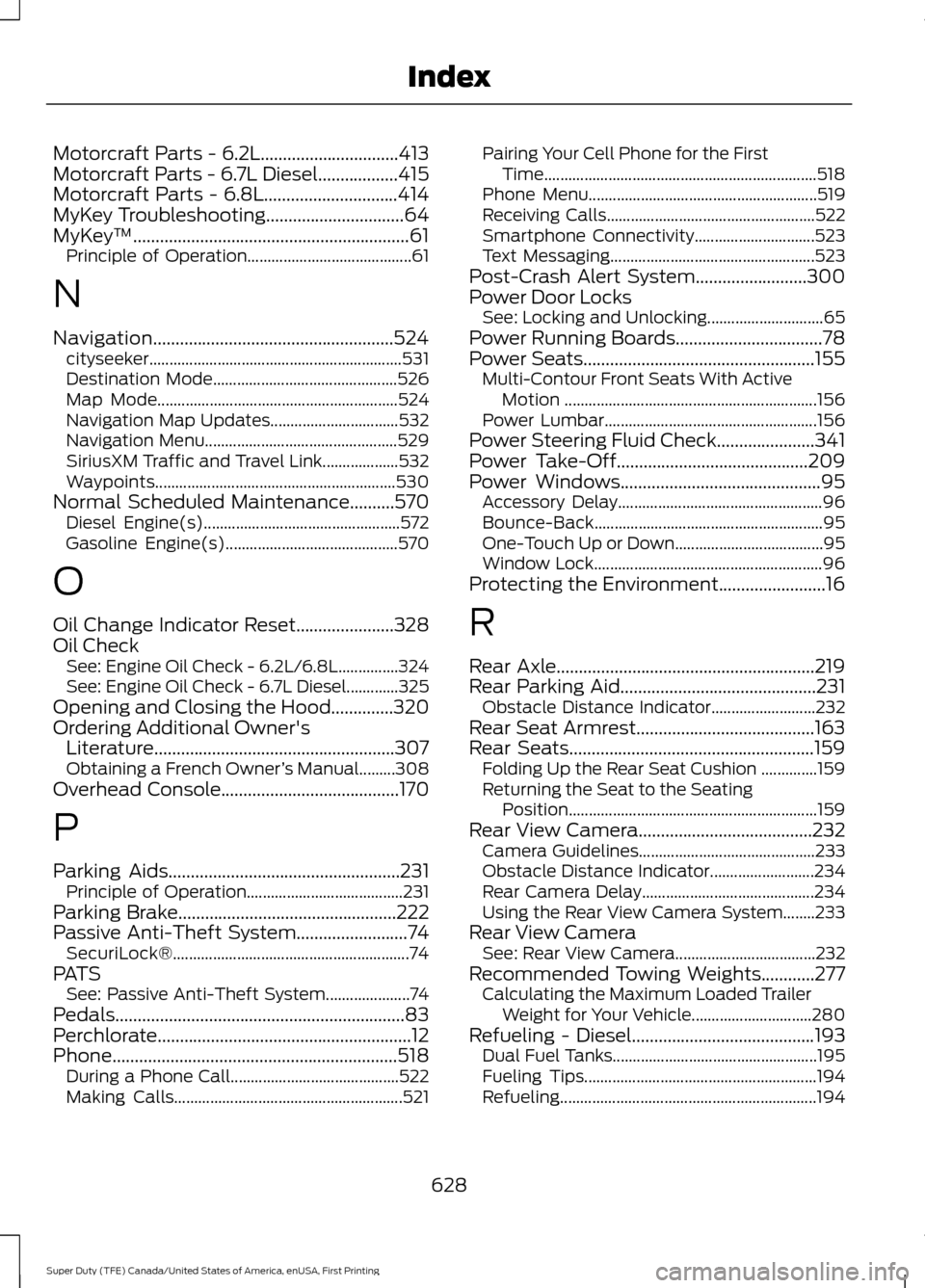
Motorcraft Parts - 6.2L...............................413
Motorcraft Parts - 6.7L Diesel..................415
Motorcraft Parts - 6.8L..............................414
MyKey Troubleshooting...............................64
MyKey
™..............................................................61
Principle of Operation......................................... 61
N
Navigation......................................................524 cityseeker............................................................... 531
Destination Mode.............................................. 526
Map Mode............................................................ 524
Navigation Map Updates................................ 532
Navigation Menu................................................ 529
SiriusXM Traffic and Travel Link...................532
Waypoints............................................................ 530
Normal Scheduled Maintenance..........570 Diesel Engine(s)................................................. 572
Gasoline Engine(s)........................................... 570
O
Oil Change Indicator Reset......................328
Oil Check See: Engine Oil Check - 6.2L/6.8L...............324
See: Engine Oil Check - 6.7L Diesel.............325
Opening and Closing the Hood..............320
Ordering Additional Owner's Literature......................................................307
Obtaining a French Owner ’s Manual.........308
Overhead Console........................................170
P
Parking Aids
....................................................231
Principle of Operation....................................... 231
Parking Brake.................................................222
Passive Anti-Theft System
.........................74
SecuriLock®........................................................... 74
PATS See: Passive Anti-Theft System.....................74
Pedals.................................................................83
Perchlorate.........................................................12
Phone
................................................................518
During a Phone Call.......................................... 522
Making Calls......................................................... 521Pairing Your Cell Phone for the First
Time.................................................................... 518
Phone Menu......................................................... 519
Receiving Calls.................................................... 522
Smartphone Connectivity.............................. 523
Text Messaging................................................... 523
Post-Crash Alert System.........................300
Power Door Locks See: Locking and Unlocking............................. 65
Power Running Boards
.................................78
Power Seats....................................................155
Multi-Contour Front Seats With Active
Motion
............................................................... 156
Power Lumbar..................................................... 156
Power Steering Fluid Check......................341
Power Take-Off
...........................................209
Power Windows.............................................95
Accessory Delay................................................... 96
Bounce-Back......................................................... 95
One-Touch Up or Down..................................... 95
Window Lock......................................................... 96
Protecting the Environment........................16
R
Rear Axle
..........................................................219
Rear Parking Aid............................................231
Obstacle Distance Indicator.......................... 232
Rear Seat Armrest........................................163
Rear Seats
.......................................................159
Folding Up the Rear Seat Cushion ..............159
Returning the Seat to the Seating
Position.............................................................. 159
Rear View Camera
.......................................232
Camera Guidelines............................................ 233
Obstacle Distance Indicator.......................... 234
Rear Camera Delay........................................... 234
Using the Rear View Camera System........233
Rear View Camera See: Rear View Camera................................... 232
Recommended Towing Weights............277 Calculating the Maximum Loaded Trailer
Weight for Your Vehicle.............................. 280
Refueling - Diesel
.........................................193
Dual Fuel Tanks................................................... 195
Fueling Tips.......................................................... 194
Refueling................................................................ 194
628
Super Duty (TFE) Canada/United States of America, enUSA, First Printing Index